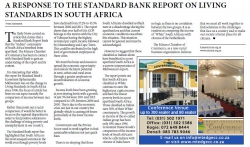A Response to the Standard Bank Report on Living Standards in South Africa2016-08-23 The Daily News carried an article that claims that a Standard Bank Report finds that the “Indian†community of South Africa benefited from apartheid. The Minara Chamber of Commerce has been in contact with Standard Bank to gain an understating of the report and its context.
It is interesting that while the report by Standard Bank’s Economist Siphamandla Mkhwanazi was on the change in Living Standards in South Africa since 1996, the focus of article has been on one aspect namely the comparison of income between race groups. Rather than point out a racial comparison, it would be better to focus on the regional disparities in order to find positive solutions to the challenge of rising poverty and unemployment in our country. The Standard Bank report has highlighted that South Africa is the most unequal societies in the world even though poverty levels have declined from 57.2% to 45.5% between 2006 and 2011. The report shows that over half of SA’s GDP belongs to the metros with the City of Tshwane having the highest nominal per capita income followed by Johannesburg and Cape Town. This could be attributed to the high level of government employees in these cities. We must find ways and means to spread the economic opportunity and unlock the latent potential in semi-urban and rural areas through a greater emphasis on decentralisation of economic growth. Income levels have been growing at ever slowing levels with a growth of just 3% between 2011 and 2015 compared to 15% between 2000 and 2005. This is due to the economic crisis not just in our country but globally which is causing job losses particularly at the lower income levels. Government and the Private Sector need to work together to find sustainable solutions not just quick fixes. There is no denying that those South Africans classified as Black were at a disadvantage during the apartheid era and that current economic conditions exacerbate this situation. This situation cannot be ignored and must be acknowledged. However to suggest that those classified as Indians alone have benefitted in a post apartheid South Africa is a narrow interpretation of Mkhwanazi’s report. The report points out that South Africans classified as White continue to earn the highest per capita income and have the lowest poverty levels in a post apartheid South Africa. Those classified as Indian earn 50% of their White counterparts. The growth in income of the so-called Indian group has been only 18% since 1996. Economist Dawie Roodt’s comparison of the income levels of South African’s who he calls Indians with citizens of India bears no logic as there is no correlation between the two groups. It is as random as comparing the income of “White†South Africans with citizens of the Netherlands. The Minara Chamber of Commerce, as a non-racial business organisation, believes that we must all work together to find solutions to the challenges that face us a country and to make our society a better place for all citizens. kzn@minara.org.za www.minara.org.za |
A Response to the Standard Bank Report on Living Standards in South Africa
Copyright © 2025 KwaZulu-Natal Top Business
